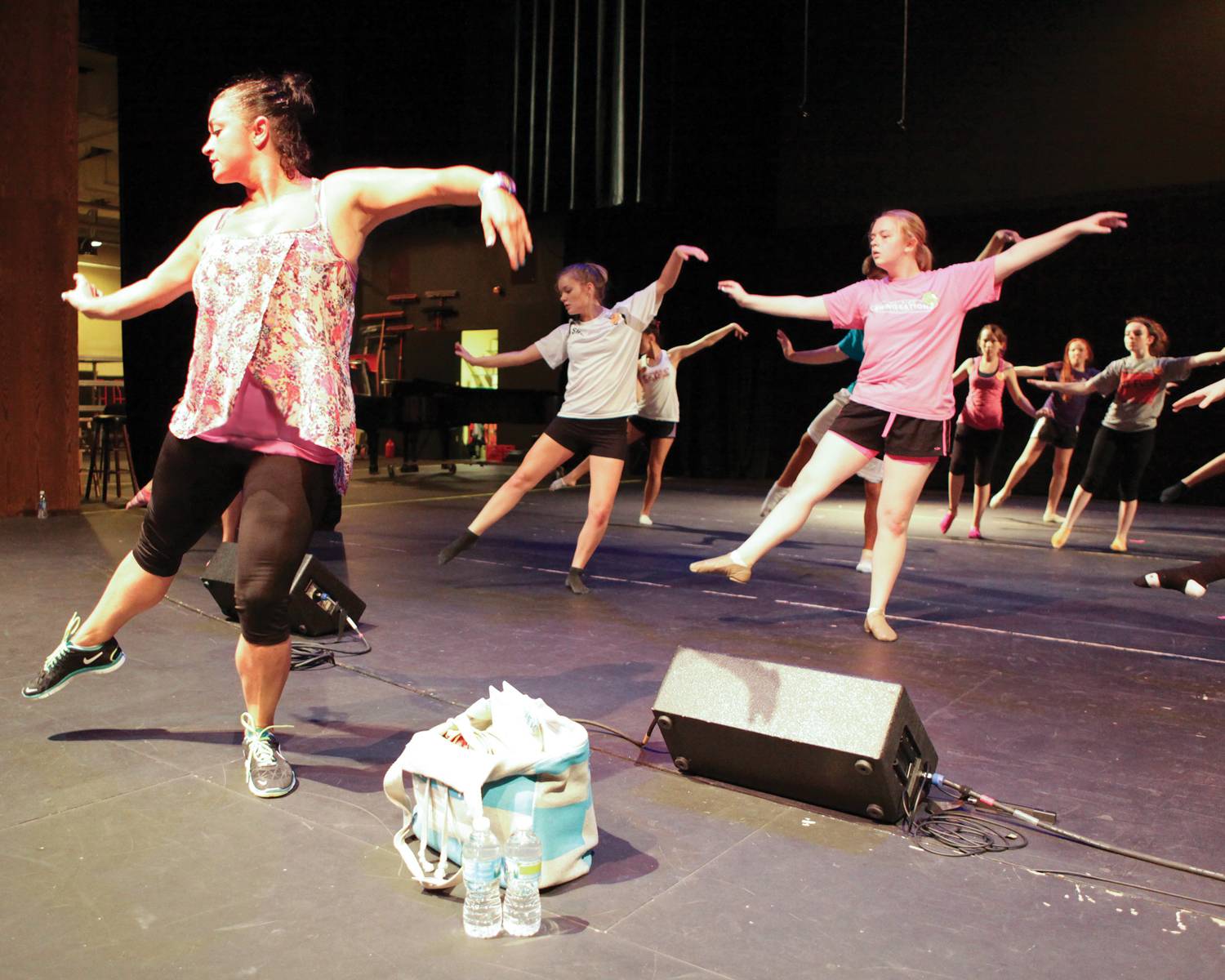
Getting Started
Be willing to negotiate your rate. Still to this day I take into consideration the size of the school, the budget granted them by the district, the level of difficulty expected for the students, the ease of getting to the school, and the history I have with the director. If you make yourself a part of a growing program, they will hopefully reward you later when they have more funds. When I started, I worked for gas money, experience, and something to put on my resume.
Attend a camp like Showchoir Camps of America. Not only do they offer workshops for new choreographers, but it’s also a fantastic way to network and get your name out there. Lots of new teachers starting new showchoir programs also attend. Have a business card (my mom made mine); it doesn’t have to be fancy-just contain all your contact information. If someone tries to contact you, reply ASAP!
Take classes whenever possible. Continuing your own education keeps you fresh and reminds you what it’s like to be a student. Never stop learning.
Don’t get caught up in the competition aspect and base your worth on results. That is a recipe for mental disaster. I’m lucky enough to almost immediately forget who won the trophy because my only true care is that the kids love what they get to do and my pride of their on-stage success washes away any less-than-desirable judging results.
Choreography Tools
You don’t have to reinvent the wheel, but DON’T STEAL. You have to find your own voice. It’s understandable that you start with a natural influence from the teachers who trained you, but not only do we older choreographers talk about the younger ones who are bringing great new things, we also are very aware of the ones that blatantly plagiarize. YouTube is a friend and potentially an enemy. Everything is out there and it will be noticed.
Have a plan B when working with a new group, but don’t resort to it too quickly. Kids desire a challenge, but don’t let your ego get in the way, if something needs to be “watered down” in order for them to succeed.
Don’t throw every step you know into a routine just to show that you have the moves. If they can’t sing while dancing elaborate or physically demanding moves, then they can’t succeed. It’s showCHOIR. Giving them moments to breathe is crucial and also helps with the visual pacing. If it’s full blown all the time, it’s too much.
Be aware of the chart/arrangement. Horn hits should be physically addressed. Also have an ongoing commentary with the director about tempo and dynamics. The visual dynamics should match the vocal dynamics. Make yourself “open” to adjustments based on the director’s plans. If the director hasn’t made those choices yet, let him or her know what your thoughts are.
Don’t fear a repeat of choreography, because it can establish a visual theme. I would, however, suggest you never do the exact same choreography three times in a piece. If a chorus of a song is in the arrangement more than 3 times, make a cut because that is excessive. If the director doesn’t allow a cut (which would be crazy), you will have to create a totally new idea for the 3rd and ungodly 4th chorus.
Blocking is very important and can help tell the story. “Dead space” (empty space) can create new shapes and help draw focus. However, try to avoid too many blocking changes just for the sake of blocking changes because it can start to feel like a marching band.
When choosing who stands where, try to be aware of height. You want the stage to feel symmetrical in a “basic windows position.” Don’t have six-foot Sally opposite of tiny Tara. I even go so far as to balance hair color when possible. The audience and even the judges won’t actively notice this, but it helps create a dynamic viewing experience. If the director chooses to place his/ her own children, simply mention these tips to them. Or show them this article.
Another blocking suggestion is not always an option, but appreciated when possible. The more faces a judge can see in the front row throughout the course of a show, the more capable the entire group seems. New faces in the front row show depth of talent-and result in more happy parents.
Teaching Tools
Come prepared!! At the same time, come prepared to be flexible. There are endless scenarios that can throw you off course. Your ability to cope and adjust is a must. You might have the basketball boys there only at the end of rehearsal, even though you planned on teaching the boys dance break first. You might have the band coming in for 30 minutes during the middle of rehearsal. Unfortunately, the directors you work for are most likely being pulled in a million directions at once, and these details could escape them. If you allow that to fluster and/or annoy you, you will create a negative learning environment.
Never yell “shut up” because that is an instant reason for them to shut down. You want them to respect you, not fear you. Create a teaching tool to assist you in gaining their focus. Some examples are “clap once if you can hear me,” and a few kids will clap; then say “clap twice if you can hear me”, and most of the kids will clap twice. I’ve almost never had to ask thrice. You can also put a silent “wolf” hand up or a peace sign or “thumbs up.” Eventually, everyone will notice, join in, and refocus their attention.
Be aware of the “blind” spaces in a room. Some facilities are amazing and allow everyone to see you all the time. Most spaces have restricted viewing, so you need to rotate the rows allowing everyone a time close to you for a better look. As I’m sure you remember, the knee jerk reaction when learning something new is to immediately want to ask questions for clarity. Reassure them that you will always do it again. That is the number one question I hear when I forget to tell them ahead of time that I will most definitely do every step several times. These are all “I care” questions from them, so you can’t get mad. Also encourage them to answer their own questions by WATCHING. “Do what I do” is one of my most common responses to a question.
Keep in mind that people learn and respond to different things. When I teach a combination, I use counts; then I’ll do the same combination to the lyrics, and then once again focusing on the rhythmic sounds and inflections of the movement. Also the imagery of an analogy can help. I often say “table top” when I mean parallel to the ground, or “act like you’re moving through wet cement” when I want them to feel more resistance in their movement. Keep trying new things. It’s always fun to see that “light bulb” turn on over a kid’s head when you’ve found the right reference.
Be aware of the learning curve in the room. Every kid learns at a different pace. My plan is to move on once the midrange learners have it. With that said, also comfort the slower learners AND understand that they have the potential to be amazing. I like to have the most confident dancers in the room raise their hands before the first break so that the ones who are struggling can know who to approach during the breaks. This is also THE WAY I find my dance captains.
If the director wants your help picking the dance captains, there are so many factors that come into play. I’m often surprised that the “best” dancer in the room is simply not dance captain material. I have referred to students like this as “style” captains. They do the moves in the style I desire, but I can tell they don’t have the patience or memory exactness to be dance captain. It’s crucial that your dance captain is someone the other kids respect; otherwise, they won’t seek the help they desire. Lots of times your mathlete is the kid that remembers the actual counts connected to the movement, even if their style isn’t perfect. Other times it’s a nurturer that cares about making the group it’s best that you want to use for one-on-one help sessions. If you are lucky enough to have a student that embodies the style, retention, patience, willingness to help, and a true desire to always make the group better, please encourage them to come to find me. I want to help these special few.
Once you are an authority figure, you have to set clear boundaries. Even if you just graduated, you need to be aware of- and care about- everyone in the room equally. If you are friends with certain students outside of the rehearsal space, you can’t allow a clique feeling to enter the room. As a leader you are granted the opportunity to diminish that outcast feeling so many high school students feel. Be the leader you have been hired to be, not just for your choreography skills, but for your leadership skills. The best part about this job is that YOU have the power to make a difference.
Final Thoughts
If you are one of the lucky few to make a career of this beautiful beast called showchoir choreographer, know that the travel is the first thing that can tear you down and wear you out. You need to actually schedule “down days” into your calendar-not just “travel from here to there” days, but actual days to allow your brain to rest. Burnout is real and only you have the power to avoid it. As my choreographer friends and I get older, we are all praying for fresh new talent that we can trust to carry on this fantastic medium due to our physically exhausted bodies. Please take care of yourself and realize that this is a marathon! Best of luck, and don’t be scared to act silly and crack a joke every once in a while…laughter in a room full of sweaty exhausted showchoir peeps can be the best medicine of all.
Photography courtesy of Lee Cave/Action Pitstop Photography











